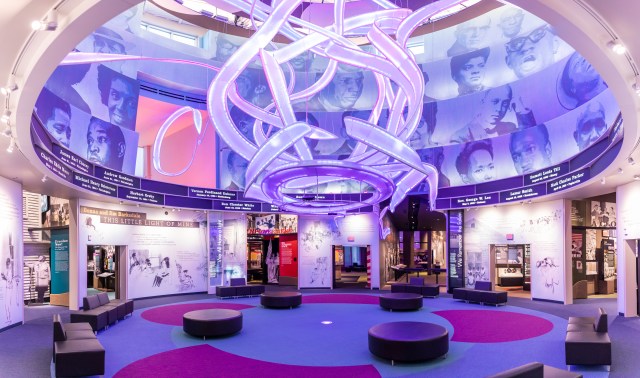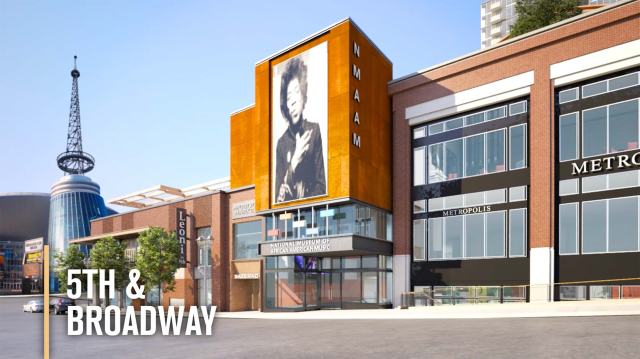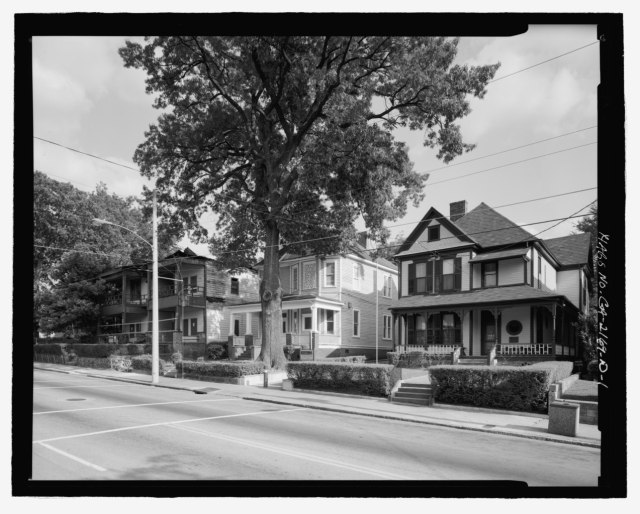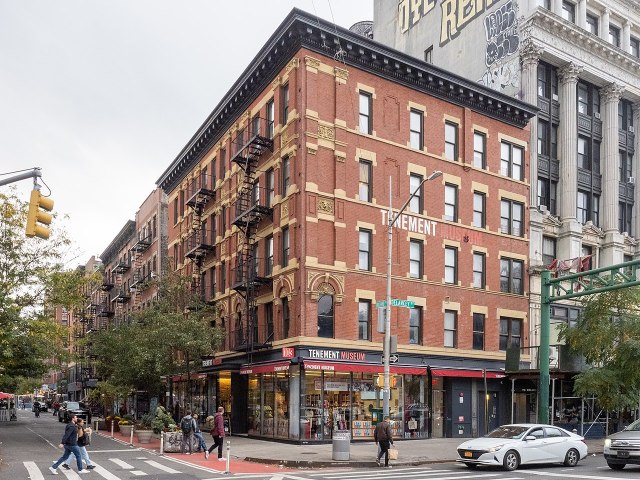24+ Places to Visit to Understand Race in America
Raising kids in one of the biggest melting pots in the world comes with a responsibility to acknowledge and celebrate all of our differences. From talking about the civil rights movement to exploring cultural traditions, it’s important we help kids learn about their own identities while also developing respect for those from other backgrounds. As a first step, visit one of these amazing historical sites and museums that help kids understand the complex realities of race and cultural appreciation.

National Museum of the American Indian - Washington, D.C.
ImagiNATIONS Activity Center at the National Museum of the American Indian was designed for kids to not only tucker themselves out but to also organically explore native culture and lifestyle. Little ones can weave a huge basket, surf a virtual river in a tippy kayak, or hunker down inside a real teepee. A library and kiddie craft center will keep bookworms engaged. The Mitsitam Cafe downstairs in the museum—serving native foods from around the Americas like fry bread and succotash—is well known and worth a visit.
Learn more: americanindian.si.edu

The National Underground Railroad Freedom Center - Cincinnati, OH
Located just a short walk from the beautiful Ohio River, this museum's mission is to "reveal stories of freedom's heroes, from the era of the Underground Railroad to contemporary times." From permanent exhibits to new and rotating exhibitions, the museum illuminates the concepts of freedom, what it means to be free, and issues of both historic and current slavery. Read the letters home from a Black soldier in WWII, what a slave pen really looked like, and the journey from being enslaved by a family to emancipation, in pictures and letters. You'll find an array of online learning resources including exhibits, lesson plans and videos.
Learn more at: freedomcenter.org

Civil Rights, Black History & Culture - Jackson, MS
Jackson, Mississippi, is famously known for the renowned Civil Rights Museum, But Jackson is also home to many lesser-known Civil Rights sites you can visit and more than one iconic walking trail, making it a great place to experience Black History any time of the year. You'll find the Mississippi Freedom Trail with ten important sites as well as the Mississippi Blues Trail which highlights the history and significance of the Blues in Jackson.
Additional spots not to miss include the Smith Robertson Museum and Cultural Center, the International Museum of Muslim Cultures, countless historic churches, and, of course, some of the best eateries in all of Mississippi.
Learn more at: visitjackson.com

El Museo del Barrio - New York, NY
At El Museo del Barrio, kids can learn the history of stickball, talk about Mexican social issues, celebrate Carnival and view the artwork of everyday life in Puerto Rico. Plus, special ArteXplorers Activity Cards from the Museum help families identify and learn about the artworks in the galleries. Super Sabado (Free Third Saturdays) teaches the vibrancy and diversity of Latino Culture through free art-making workshops, storytelling, concerts, and more.
Learn more: elmuseo.org

The National Museum of African American Music - Nashville, TN
Just opened in Music City, this highly-anticipated museum is the only museum dedicated to educating, preserving and celebrating more than 50 music genres and styles that were created or inspired by African Americans. The 56,000 square foot museum will be located at 5th and Broadway, in the heart of Nashville, and will include artifacts, objects, memorabilia, clothing and state-of-the-art technology to showcase different narratives and genres.
Learn more: nmaam.org

Wounded Knee Museum - Wall South, SD
On your way to Mt. Rushmore and the Black Hills, be sure to take a detour to the Wounded Knee Museum in Wall South. There you'll find exhibits and pictures that vividly present the massacre of over 300 men, women and children from the Lakota nation by the 7th Calvary of the United States Army on December 29th, 1890. Your kids will see firsthand the tragic events that are, sadly, a common narrative in Native American history. You can also visit the actual historical site, geared up with information from the museum. The museum is also home to "Lakota Ways: A Cultural Experience," which celebrates the Lakota Nation, which is still active in the area today.

Belle Meade Plantation- Nashville, TN
You’d think the last thing you’d want to do to understand race in America is to visit the grounds of a plantation that once used enslaved people to make its wealth. But after a recent visit to Belle Meade Plantation in the Nashville area, we can report first-hand that this historic property is at the forefront of talking with the public in a truthful way about the horrors of slavery while honoring the African-American history of the property. The Journey to Jubilee tour follows the story of the African-Americans who were brought to the plantation in 1807, but who stayed on the plantation through the early 1900s. It shows their vital presence on the property, their story of enslavement to freedom and provides visitors with an understanding of the times from the African-American viewpoint. This tour is not recommended for kids under 12 due to the graphic reality of slavery, however, the general tour of Belle Meade also incorporates the story of the African-Americans who came as slaves but stayed on as hired workers after the abolishment of slavery. The property itself is very kid-friendly and an excellent respite from the bustle of the city.

Little Rock Central High School National Historic Site - Little Rock, AR
The Little Rock Central High School was the most prominent example of the desegregation of public schools in 1954 when nine African-American students attended school here for the first time in history. You have to arrange a tour to enter the school, now designated a National Historic Site, but it’s relatively easy to do and a great way to help kids understand the significance of this school as well as the history of desegregation in the U.S.

Ellis Island - New York, NY
A quick boat ride from the Statue of Liberty, Ellis Island (now known as the Ellis Island National Museum of Immigration) is where 12 million immigrants were processed before moving on to New York City and beyond to make a new life between 1892 and 1954. The museum's showpiece is the Great Hall, where all of the immigrants were processed. The museum shows how the hall changed over the years, in addition to a slew of artifacts, photographs, prints, videos, and interactive displays. One of the coolest things about this museum is that, thanks to the American Immigration History Center, you and the kids can try to trace your own heritage back to Ellis Island and a relative who may have been processed there.

Angel Island- San Francisco, CA
Now a state park, Angel Island boasts some of the best views of San Francisco and Marin counties around, but don't just go for the photo opps. In 1905 an Immigration Station was constructed, which began operating in 1910. Because of the 1882 Chinese Exclusion Act, a law passed limiting the number of Chinese immigrants into the US, anti-Chinese sentiment, particularly in the San Francisco Bay Area and throughout California, was rampant. While the station at Angel Island was meant to be a processing center, many immigrants primarily from Asia (and most from China) were held for interrogation. While they were supposed to be held for just a few days, in some cases they were held for nearly two years. Detainees expressed their feelings in poetry carved into the wooden walls of the detention barracks, still legible today. The Angel Island Immigration Station Foundation is an excellent resource to learn more. Find our guide to Angel Island here.
The Chickasaw Cultural Center - Sulphur, OK
Learn and connect with First American History at this center for arts and culture. Performances, reenactments, classes, demonstrations, collections and interactive exhibits all work together beautifully to educate and inform visitors of the story of the Chickasaw people. This is one of the largest and most extensive tribal cultural centers in the United States and is operated entirely by the Chickasaw Nation. Located on 184-acres, you'll find not only the exhibit center but The Center for the Study of Chickasaw History and Culture, a theater, the Inchokka' Traditional Village as well as First-American foods and goods for purchase.
Learn more at: chickasawculturalcenter.com

The Legacy Museum - Montgomery, AL
The museum depicts the history of black people in the United States, beginning with slavery, through Jim Crow laws and segregation, to current issues of mass incarceration. The memorial, a quick walk away, honors 4,000 victims of lynching and racial violence. By filling in the gaps in the history that many Americans learn in school, the content presented may help families initiate discussions related to race and inequality in the United States

Martin Luther King Jr. National Historic Site - Atlanta, GA
Take your kids back to where this leader of the Civil Rights Movement was once a kid. At the Martin Luther King Jr. site, you can visit his birth home, play where MLK played as a child and learn all about his early years in the movement. Get inspired to fight inequality in your neck of the woods.

Tenement Museum - New York, NY
Get a recount of daily life from more than a hundred years ago in America in a preserved tenement building at the Lower East Side Tenement Museum. Tour the preserved building that housed 7,000 working-class Irish and Jewish immigrants from 1863 until 1935.

Museum of African Diaspora - San Francisco, CA
Celebrating the universal connection of all people through their association with Africa, this must-visit museum showcases exhibitions aimed at representing work that may be under-represented in other U.S. museums. For example, as soon as you walk in, you're greeted by a three-story mural comprised of 2,100 photographs submitted by people of the Diaspora.
Chattanooga, TN
A visit to Chattanooga, TN is full of opportunities to learn about Black history.
Founded in 1983 as the Chattanooga African American Museum, the Bessie Smith Cultural Center celebrates the African Diaspora and pays tribute to Chattanooga’s African American culture with an emphasis on Bessie Smith, “The Empress of the Blues.” The BSCC is undergoing renovations and is set to reopen in the spring of 2021.
A new mural project called "The Soul of MLK” is in the works and will add to the revitalization of the MLK District, and across town at the southern entrance of the Walnut Street Pedestrian Bridge, the Ed Johnson Memorial will be completed this spring as well. The memorial is a permanent public site that strives to promote racial healing and reconciliation by acknowledging the lynching of Ed Johnson, honoring the courageous work of his attorneys, and recognizing the resulting U.S. Supreme Court case that established federal oversight of state-level civil rights issues.

National Museum of American Jewish History - Philadelphia, PA
Located on historic Independence Mall, this museum brings to life the 360-year history of Jews in America. Through more than 1,200 artifacts, films, and interactive exhibitions, this family-friendly museum tells the struggles of an immigrant population that ultimately flourished in a foreign land.

Civil Rights Lessons - Greensboro, NC
In Greensboro, NC ,your kids can visit the site of the first Civil Right's sit-in and learned about the A&T Four— four young African-American students who sat at a “Whites Only” counter inside the Woolworth restaurant on Feb. 1, 1960 and refused to move. At the the International Civil Rights Center & Museum, a guided tour helps your family learn and relearn important facts about America’s history before, during and after the Civil Rights Movement. The Greensboro Cultural Arts Center houses the African America Atelier where you will find moving exhibits that the whole family will enjoy. And you'll want to visit the Guilford College Underground Railroad trail, which simulates how fugitives seeking freedom navigated in the woods on the Guilford College community with assistance from free and enslaved African-Americans and European-American Allies.

Explore Richmond's Legacy - Richmond, VA
Richmond is steeped in important Black history and here are just a few of the ways you can experience it with your kids.
Visit the home of Maggie Lena Walker, a newspaper editor, bank president and champion of civil rights for African Americans and women. Join a tour of her home and an exhibit hall, watch a short film about her life and walk in the footsteps of a great activist of the early 20th century. There's also a Maggie L. Walker Memorial Plaza.
The Black History Museum & Cultural Center of Virginia celebrates the rich culture and history African Americans people in Virginia and has permanent exhibits that explore Jim Crow, Reconstruction, Emancipation and more.
You can also explore Richmond’s monuments: Virginia Civil Rights Memorial on the Capitol grounds, Slavery Reconciliation Statue, Henry Box Brown, Bill “Bojangles” Robinson monument and the Arthur Ashe monument on Monument Ave. There's also a self-guided Richmond Slave Trail: Walk along and discover seventeen different markers that display the somber truth about slavery in Richmond.
At the Virginia Museum of Fine Arts entrance along historic Arthur Ashe boulevard, you'll find Rumors of War, a powerful sculpture by Black artist Kehinde Wiley’s. You'll also currently find the the Marcus-David Peter Circle (Robert E. Lee Monument) where artist Dustin Klein's light projections on the statue of Robert E. Lee include images and videos of Black citizens who are victims of police brutality, including Breonna Taylor and George Floyd, as well as projects of iconic Black leaders like Frederick Douglass, Harriet Tubman, Billie Holiday, and Malcom X.
Discover even more at visitrichmondva.com

National Museum of African-American History and Culture- Washington, D.C.
The stunning building, inspired by Yoruba art and filigree ironwork, is filled with presentations and artifacts that give visitors a glimpse at all aspects—the good and the gut-wrenching—of the African American experience. It’s a must-visit for the entire family. See our in-depth guide here.

Wing Luke Museum - Seattle, WA
"The Wing," as it is affectionately called by locals showcases the history, art and culture of Asian Americans in the Pacific Northwest. Check out KidPlace, the Museum’s dedicated gallery to kids and families that is always open and filled with colorful and playful interactive exhibits.

Rosa Parks Memorial - Montgomery, AL
Smack dab on the corner where Civil Rights activist Rosa Parks boarded a public bus and where she was infamously arrested for refusing to give up her seat to a white passenger, this museum focuses on Parks' story and its place in the Civil Rights Movement. The Museum includes a permanent exhibit, “The Cleveland Avenue Time Machine,” a replica city bus that uses fog, lighting, sound, hydraulics and a robot bus driver to guide visitors are on a series of “time jumps” from Jim Crow to “Separate But Equal.”

Japanese American National Museum - Los Angeles, CA
Whether your kids know very little about Japanese American culture or they have a budding interest in the country that invented sushi, this is a perfect place to begin their journey. JANM hosts both permanent and temporary exhibitions as well as Free Family Fun days to bring to life the interesting, fun and sometimes grounding aspects of Japanese American history and culture.
Harriet Tubman National Historical Park - Auburn, NY
If your kids don’t already know who Harriet Tubman is, the national park that bears her name is the perfect place to learn all about this incredible woman who emancipated herself from slavery at the age of just 27 and went on to help dozens of slaves find freedom. Before you go, the kids can become an Underground Railroad Junior Ranger to learn about the system of secret houses and way stations that helped slaves find freedom in terms they can understand. Harriet Tubman National Historical Park includes her home, a visitor’s center, the Harriet Tubman Home for the Aged, and the church she raised funds to build. Her burial site is also nearby.
—Kate Loweth, Ayren Jackson-Cannady & Amber Guetebier
RELATED STORIES:
Parent’s Guide to the National Museum of African American History and Culture
14 African-American History Books to Read with Your Kids